FBI Laboratory Makes Tool Mark Examinations
Scientific Aids
FBI Law Enforcement Bulletin, September 1950
Introduction
Year after year, burglaries, robberies and house breakings are high in the statistical compilation of major crimes committed in the United States. Perpetrators of these crimes often "vanish into thin air." Many times the investigator does not have eyewitnesses whom he can call upon to aid him in solving his case. However, the criminal may leave an important clue which the investigator cannot afford to overlook. The screw driver used to force open a drawer or the bolt cutters used to cut the hasp of a lock may finally lead to the subject's apprehension and conviction.
See also the instructional video "Casting Tool Mark Impressions with Mikrosil"
The Examination
Generally speaking, toolmark examinations fall into two groups. The first group consists of those examinations where the investigator has no suspects and submits the toolmarks for the purpose of determining the type of tool used. Examinations of this type are based on the fact that a tool may leave characteristic impressions in an object upon which it is used. By measuring the size and noting the characteristic shape of the impression as well as the nature of the material containing the impression, identity of the type of tool involved may be determined. For example, an examination may reveal that a tool employing a cutting, shearing, pinching or striking action was used. Such tools as knives, razor blades, and axes may be said to employ a cutting action. Scissors and metal shears may be included in the types of tools employing a shearing action. Electrician's plier and sidecutters employ a pinching action and hammers are included in the types of tools employing a striking action.
Examinations of this type will often aid in reducing the scope of an investigation by helping the investigator to eliminate certain tools which he may recover, eliminate certain suspects or, in certain cases, through an analysis of the facts, permit the investigator to close his investigation by showing that the damage was accidentally produced rather than intentionally produced. For example, a microscopic examination of a pair of wires believed to have been cut may show they broke apart as a result of stress or tension.
The second group of examinations consists of those where the toolmarks and tools are submitted for comparison and possible identification. Tool mark identification is similar to that employed in firearms comparisons. Just as guns leave their characteristic markings on bullets and cartridge cases fired in them, so, too, tools can often be identified as having produced an impression or set of markings on an object. Such identifications are based upon the accidental defects present in the striking surface, cutting surface, or bite of the tool used. These defects may be produced in the manufacture of the tool as well as in the subsequent use of it. To cite an example, on February 26, 1949, a loan company, located in Arlington, Va., was broken into. Entrance was gained by breaking and forcing a transom above the front door. A police patrol car cruising the area noted a shadowy figure slinking away from the loan company. The subject was taken into custody and upon search of his person, a knife was found in his pocket. This knife and a piece of the transom were forwarded to the FBI Laboratory for examination. Figure 1 shows a piece of the transom submitted and figure 2 shows the pocketknife obtained from the suspect. Figure 3 is a photomicrograph showing a comparison of the marks in the piece of transom with test marks produced by the blade of the suspect's pocketknife.

Figure 1

Figure 2
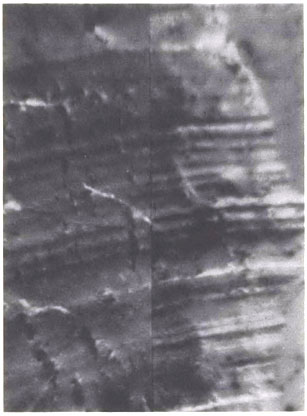
Figure 3
It will be noted that running down through the center of the picture is a hairline. The area on the left represent. the markings found on the submitted piece of wood. The area on the right represents the test impressions produced by the suspect knife. In the course of the use of this little nick and defect were produced along the cutting surface of the blade. When used to cut the piece of wood shown in figure 1, these nicks and defects left corresponding ridges and grooves in the wood. The matching of the markings common to the two impressions, as shown in figure 3, permitted positive identification of this knife a having been used to cut the piece of transom submitted.
On November 16, 1949, a letter was received from the Twin Falls, Idaho, Police Department advising that it was investigating a series of poisonings. Approximately 11 dogs had been killed as a result of having been fed some poisoned fish. Three cans picked up near the home of a suspect were examined and all were found to have contained strychnine. The cans were submitted to the FBI Laboratory along with two can openers found in the home of the suspect. Figure 4 shows the indentations left in the can by the can opener. Figure 5 is a photomicrograph showing the comparison of the markings on one of the cans and those produced by one of the suspect can openers submitted. As a result of this comparison, one of the can openers was identified as having been used to open one of the cans submitted. This case is a good example of the unusual nature of some of the toolmark examinations and comparisons which have been and are made regularly in the FBI Laboratory.
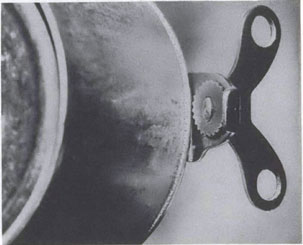
Figure 4
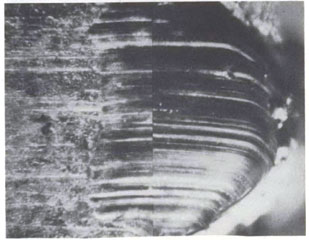
Figure 5
The cases cited above have all been of the type where the identification of the tool employed has been effected as a result of an examination of the scrape marks or friction marks left by the tool on the object. However, a screwdriver used to pry open a window, although it does not scrape across the surface of the wood, may leave a characteristic impression or imprint in the wood by which it may be identified.
On the morning of May 27, 1949, officers of the Boulder, Colo., Police Department discovered that a door had been forced open into a building occupied by a food company. Subsequent investigation showed that a safe had been removed from the office and hauled away.
Later that same morning, a Ford pick-up truck bearing Oklahoma license plates was stopped. In the pick-up truck were found numerous tools including an ax, a sledge hammer, and a cold chisel. The safe of the burglarized company was found 4 miles outside the city where it had been broken open and the contents rifled.
Parts of the safe, the tools found in the Ford truck, and a small piece of metal found in the safe were forwarded to the FBI Laboratory.
Figure 6 shows the ax which was found in the truck. It will be noted that there is a large nick in the blade of the ax. Figure 7 shows the manner in which the small piece of metal found in the safe was fitted into and identified as having originally been part of the ax blade.
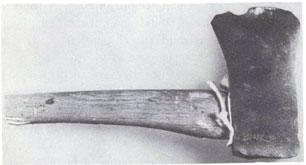
Figure 6
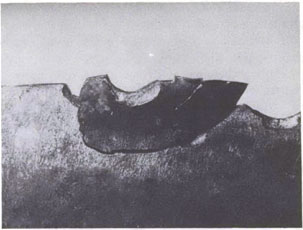
Figure 7
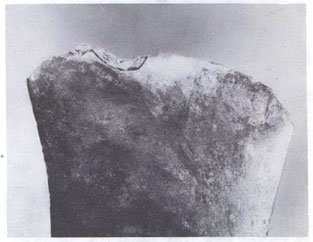
Figure 8
The safe door was found to have been ripped open as a result of being struck numerous blows by a tool similar to an ax. Figure 8 shows one of the characteristic impressions in the face of the safe door produced by the defect in the ax blade by which the submitted ax was identified as having been used to break open the safe door.
A telegram was forwarded immediately upon completion of this examination advising the police department of the results. When confronted with the laboratory's findings, the subjects pleaded guilty.
Many times the object struck may be of a harder material than the tool used. Consequently, the characteristic markings which may form the basis of an identification may be found on the tool rather than on the object struck. On February 11, 1950, a hardware company located in Alexandria, La., was burglarized. Found in the woods was a hammer, the head of which was made of bronze. Upon examination an impression similar in size and design to a lock keyway was found in the head of the hammer. Another circular impression was found on the face of the hammer the same size as this lock keyway. At the top of this impression was found a design resembling the knurling of the keyway or one similar to it with respect to size and design.
Often the problem arises in the mind of the contributor, upon visual examination of the mark ing, whether or not they are too minute or whether there are any markings actually present by which an adequate comparison can be made. In the event such a question does arise, the investigator should resolve all doubt in favor of submitting the questioned material for examination. For example, figure 9 shows a stapling machine used in the stapling of lottery tickets involved in a case investigated by the FBI. Figure 10 shows the size of one of the e staples as compared with an ordinary match. As each staple was cut, the cutting edge of the machine left a series of markings on the ends of the staple 0 produced. Figure 11 shows a comparison of the end of one of the staples removed from one of the lottery tickets with a staple produced by the suspected machine. A number of staples were identified in this way which aided materially in the final disposition of this case.
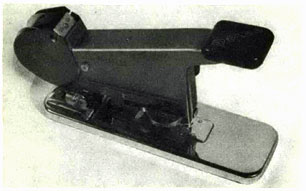
Figure 9
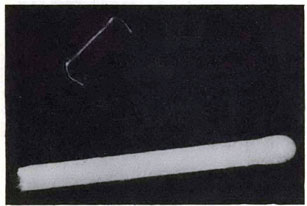
Figure 10
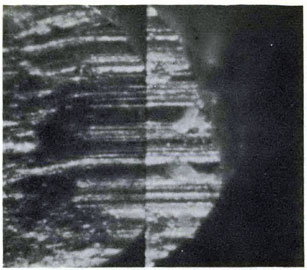
Figure 11
The Letter of Request
Briefly, a letter requesting the FBI Laboratory to conduct certain examinations should contain the following:
- Name of the suspect or suspects, when known.
- Name of the victim or, in the case of a burglary or robbery, the place burglarized or robbed.
- Nature of the crime committed (burglary, robbery, breaking and entering, etc.).
- The facts of the case, in brief. The facts of the case are of extreme importance because knowledge of them enables the examiner to make a complete analysis of the evidence transmitted. In other words, the examiner may conduct additional examinations of the evidence in addition to those requested which he believes may be of value either in further investigation or prosecution of the case.
- A list of the evidence transmitted.
- The examinations desired of the transmitted evidence. Quite often the investigator submitting the evidence may not be aware of all the examinations which may be conducted. Therefore, a brief statement as to what in general the investigator desires to prove through examination of the evidence may be of value in aiding the examiner to make a complete examination.
- What disposition is to be made of the evidence; that is, to whom and where it is to be returned.
- A statement as to whether the evidence has been subjected to any previous examination.
Obtaining and Submitting the Evidence
Whenever and wherever possible the actual tools and impressions to be compared should be forwarded to the FBI Laboratory. Only in extreme cases should casts be made of the impression. The reason for this is simply that the casts do not usually reproduce those microscopic markings in the impression which will permit the identification of the particular tool used.
The investigator should be careful not to permit any suspect tools while in his hands to come in contact with the object containing the markings.
In shipping the evidence to the FBI Laboratory, the transmitted objects should be wrapped separately before being placed in the shipping carton, in order to prevent. the objects from coming in contact with each other. Often spectrographic and spetrographic examinations are made of paint, metal, safe insulation and other foreign material found on either the tools or objects containing the tool marks which will permit association of one with the other, and by wrapping the articles separately, contamination will be avoided.
At the beginning of this article it was mentioned that toolmark identification is similar to firearms examination. Toolmark comparisons, however, are often more difficult than those encountered in the comparison of bullets, cartridge cases, and firearms. The bullet fired through a gun barrel follows a set path determined by the rifling of the gun barrel. There are, however, many ways in which a tool can be held to produce a particular set of markings or impressions. Often the material in which the impression is made may be of such a nature that it does not make a clear impression. Again, subsequent use of the tool may cause changes in the bit or cutting surface of that tool. Consequently, in the absence of sufficient marks for identification purposes, a report may reflect that the particular tool submitted or one similar in size and shape. or cutting action was used to produce the damage, as illustrated in the conclusion reached as a result of the examination of the evidence in the burglary of the hard ware company previously mentioned. Therefore, even though positive identifications cannot be made in all cases involving toolmark examinations, such examinations may prove of value in furnishing important leads to the investigator.
Burglary Scene Yields Evidence
At 2: 40 a. m. on December 30, 1949, an employee of a mill in Saiisbury, N. C., observed two men flee from a window at the mill office. Police officers were summoned by telephone and the two men, identified as Manuel Savanus Miller and David Frank Canup, were promptly taken into custody.
At the time of arrest Miller threw down a pair of cloth gloves: These were recovered by officers. Search of Miller's person yielded a screw driver approximately 10 inches long. Canup had a pair of cloth gloves identical to Miller's. Further search revealed numerous burglar'S tools in the area.
One window in the mill office had been forced open. A heel print was found about 4 feet from the window and an impression, evidently made by the knee of one of the subjects, was found. A plaster cast of the latter impression revealed markings similar to corduroy material which subject Miller was wearing at the time of apprehension. A car, registered in the name of Miller and containing additional tools, was parked approximately two blocks from the mill.
A check revealed that one of the men was reported to be a safe cracker. The other had served time for receiving stolen goods.
Numerous specimens were forwarded to the FBI Laboratory for examination. Two laboratory examiners testified in superior court, Salisbury, N. C., February 14, 1950, relative to the examinations conducted. One technician testified that paint on a screw driver taken from one of the suspects was of the same composition as paint on a piece of weather stripping taken from the window where the breaking attempt had occurred. The second examiner testified that marks appearing 011 this same piece of weather stripping were made by the same screw driver which was taken from one of the subjects.
Prior to the testimony of the FBI examiners, the subjects pleaded guilty to the charge of breaking and entering to commit a felony. It was necessary, however, that their testimony be heard so that the judge might pass sentence.
Subject Miller, who had a record of convictions for similar offenses, received a sentence of 18 months. Subject Canup was sentenced to 12 months.
See the original article
Article posted May 25, 2024

